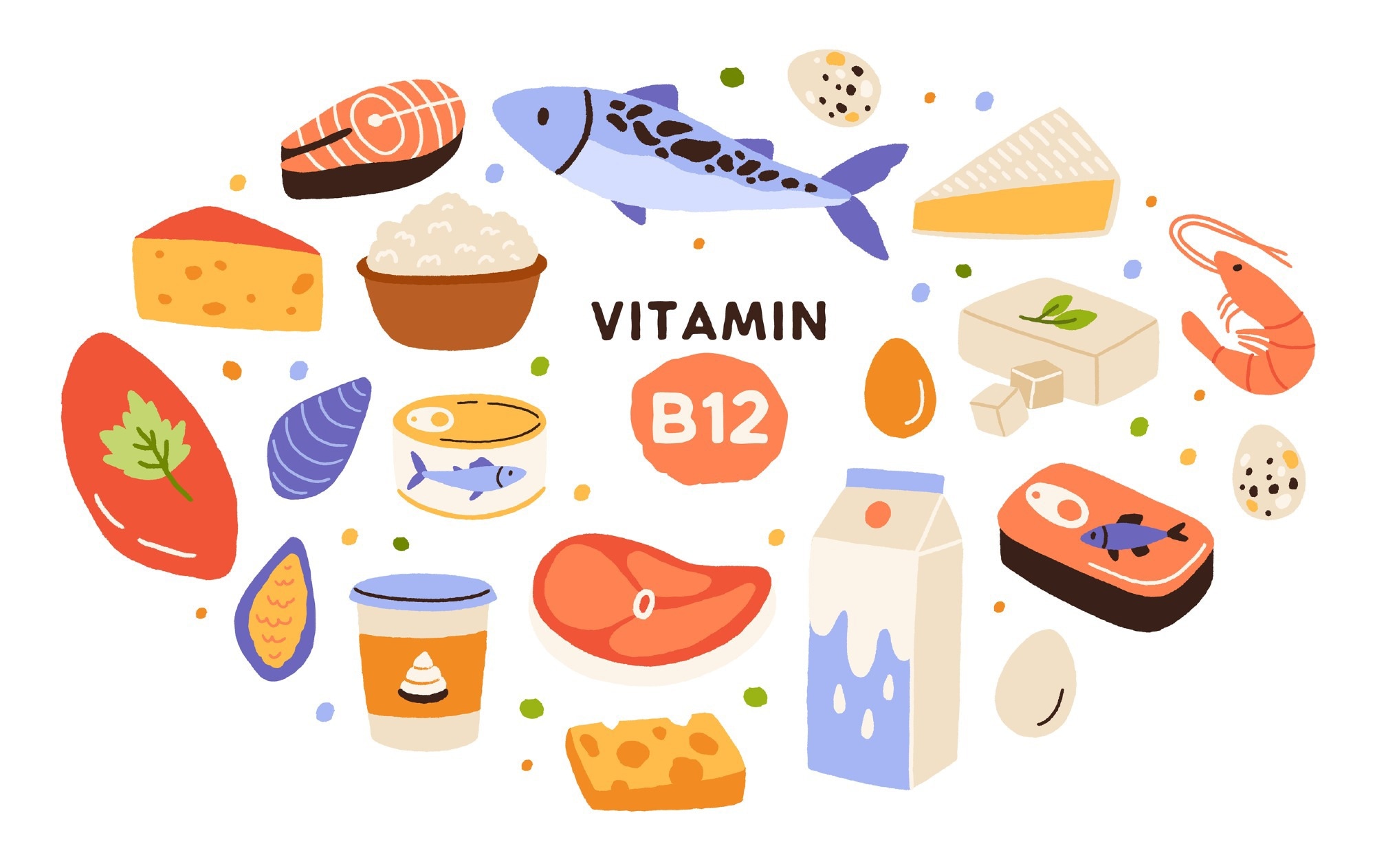Introduction
What is vitamin B12?
Best natural food sources of vitamin B12
Health benefits of vitamin B12
Recommended intake and deficiency risks
Safety and excess intake
Present limitations and research gaps
Conclusions
References
Further reading
Explore how vitamin B12 supports the brain and nervous system, why deficiencies persist even in well-nourished populations, and what new research reveals about improving diagnosis and dietary strategies.
 Image Credit: Tatjana Baibkova / Shutterstock.com
Image Credit: Tatjana Baibkova / Shutterstock.com
Introduction
Vitamin B12 is essential for red blood cell formation, neurological function, and DNA synthesis, yet deficiencies remain common due to poor absorption or limited dietary intake. This article examines natural sources, health benefits, and current research gaps in vitamin B12 metabolism and brain health.1,3,4.
What is vitamin B12?
Methylcobalamin, one form of vitamin B12, supports methionine synthase in converting homocysteine to methionine. This process is vital for creating S-adenosylmethionine (SAMe), a universal methyl donor for DNA, proteins, and neurotransmitters.1,3
In its 5-deoxyadenosylcobalamin form, vitamin B12 acts as a cofactor for L-methylmalonyl-CoA mutase, critical for metabolizing fatty acids and amino acids to support energy production and hemoglobin synthesis. The L-methylmalonyl-CoA mutase pathway contributes to the development and maintenance of the myelin sheath that insulates nerves, with even minor myelin deficiencies leading to neurological symptoms.3,4
Because vitamin B12 is almost exclusively found in animal-based products, vegetarians and vegans are more susceptible to deficiency without dietary fortification or supplementation. Plant foods do not naturally contain vitamin B12; fortified foods and supplements provide bioavailable sources for those avoiding animal products. Deficiency increases the risk of megaloblastic anemia, characterized by impaired DNA synthesis and macrocytosis, as well as severe, sometimes irreversible, neurological damage.1,2,3,4
Best natural food sources of vitamin B12
Synthesized by microorganisms, vitamin B12 is accumulated in animals and animal-derived products.1,4
Organ meats and shellfish are the richest dietary sources, with a 3-ounce (85 g) serving of cooked clams providing approximately 84.1 µg, while beef liver contains about 70.7 µg.1 Fatty fish, such as trout and salmon, supply 5.4 µg and 4.8 µg per 3-ounce serving, respectively.1
Fortified nutritional yeasts can contain up to 24 µg vitamin B12 per 50 g serving, and fortified cereals up to 6 µg per portion. For vegetarians (but not vegans), dairy products provide meaningful amounts: one cup (240 mL) of low-fat milk offers 1.2 µg, and one ounce (28 g) of Swiss cheese provides 0.9 µg.1
Once ingested, vitamin B12 absorption requires gastric acid and intrinsic factor. In food, B12 first binds to haptocorrin in saliva and gastric fluid, is released by pancreatic enzymes in the duodenum, then complexes with intrinsic factor for receptor-mediated absorption in the distal ileum.1,3 This process is often impaired in older adults due to atrophic gastritis, increasing deficiency risk even when intake meets dietary recommendations.4
Recent research indicates that vitamin B12 exhibits source-specific bioavailability: B12 from dairy products is roughly three times more bioavailable than that from meat, fish, or poultry, making dairy an especially efficient source.1
 Image Credit: GoodStudio / Shutterstock.com
Image Credit: GoodStudio / Shutterstock.com
Vitamin B12 Content of Selected Foods
| Food |
Micrograms (µg)
per serving |
Percent
Daily Value (DV)* |
| Beef liver, cooked, pan fried, 3 ounces |
70.7 |
2,944 |
| Clams (without shells), cooked, 3 ounces |
17 |
708 |
| Oysters, eastern, wild, cooked, 3 ounces |
14.9 |
621 |
| Nutritional yeast, fortified, from several brands (check label), about ¼ cup |
8.3 to 24 |
346 to 1,000 |
| Salmon, Atlantic, cooked, 3 ounces |
2.6 |
108 |
| Tuna, light, canned in water, 3 ounces |
2.5 |
104 |
| Beef, ground, 85% lean meat/15% fat, pan browned, 3 ounces |
2.4 |
100 |
| Milk, 2% milkfat, 1 cup |
1.3 |
54 |
| Yogurt, plain, fat free, 6-ounce container |
1.0 |
43 |
| Breakfast cereals, fortified with 25% of the DV for vitamin B12, 1 serving |
0.6 |
25 |
| Cheese, cheddar, 1½ ounces |
0.5 |
19 |
| Egg, whole, cooked, 1 large |
0.5 |
19 |
| Turkey, breast meat, roasted, 3 ounces |
0.3 |
14 |
| Tempeh, 1/2 cup |
0.1 |
3 |
What does %DV mean for vitamin B12?
% Daily Value (%DV) shows how much vitamin B12 a serving of food provides toward the 2.4 µg daily goal for adults.
For example, if a food has 25% DV B12, one serving provides about one quarter of your daily B12 needs. |
Health benefits of vitamin B12
Vitamin B12 deficiency can cause peripheral neuropathy and cognitive impairment due to its critical role in maintaining nervous system integrity.3 Therapeutic replacement in overt deficiency is standard of care, and in diabetic peripheral neuropathy, supplementation improves symptom and pain scores though objective neurophysiologic measures may not consistently change.5,6
Deficiency also disrupts red blood cell maturation, leading to megaloblastic anemia accompanied by fatigue and weakness.3
Although low vitamin B12 levels are often linked to depression, a 2021 meta-analysis of randomized trials in individuals without advanced neurological disorders found no significant effect of supplementation on depressive symptoms or overall cognition; observational associations with cognitive decline remain mixed.7,8
Recommended intake and deficiency risks
The U.S. National Institutes of Health (NIH) recommends 2.4 µg vitamin B12 daily as the Recommended Dietary Allowance (RDA) for adults. This increases to 2.6 µg during pregnancy and 2.8 µg during lactation to account for fetal development and milk production.1
Because the liver stores substantial amounts of vitamin B12, deficiency may take years to appear. Early warning signs include fatigue, weakness, paresthesia, balance problems, memory loss, and depression.1
High-risk groups requiring regular monitoring include vegans and vegetarians, older adults with reduced absorption, individuals with pernicious anemia or gastrointestinal disorders, and those using medications such as metformin and proton pump inhibitors.1,2,3
5 Signs and Symptoms of Vitamin B12 Deficiency
Safety and excess intake
As a water-soluble vitamin, excess vitamin B12 is usually excreted in urine. No Tolerable Upper Intake Level (UL) has been established, and B12-related toxicity is not regarded as a clinical concern.1
Some studies have reported a possible, though inconclusive, association between very high serum vitamin B12 levels and certain chronic health outcomes, emphasizing adherence to RDA values unless higher doses are medically indicated.2
Present limitations and research gaps
Despite decades of study, challenges remain in assessing vitamin B12 status. Serum measurements may not accurately represent intracellular levels, while markers such as methylmalonic acid (MMA) and homocysteine, though sensitive, lack specificity, especially in older adults and those with renal impairment.1
A recent study found that older adults with low-normal vitamin B12 concentrations exhibited slower visual-evoked potentials, age-dependent processing-speed deficits, and increased white-matter hyperintensity volumes compared with those having high-normal levels. Conversely, elevated levels of the biologically inactive holo-haptocorrin fraction correlated with serum Tau, a biomarker of neurodegeneration. These findings suggest that subclinical neurological effects may occur at higher thresholds than the current anemia-based definition of deficiency, warranting reassessment of diagnostic cutoffs.1–4,9
Conclusions
Vitamin B12 occurs mainly in animal-derived foods, emphasizing the need for dietary awareness among individuals consuming plant-based diets or those with impaired absorption.
Given the risk of irreversible neurological damage and the limitations of current diagnostic methods, increased clinical vigilance for at-risk populations is essential. Future research should refine deficiency definitions and develop more sensitive diagnostic tools to detect early, subclinical vitamin B12 insufficiency, particularly in aging populations.
References
- National Institutes of Health, Office of Dietary Supplements. (02 July 2025). Vitamin B12: Fact sheet for health professionals. https://ods.od.nih.gov/factsheets/VitaminB12-HealthProfessional/. Accessed 22 September 2025
- Mayo Clinic. (13 August 2025). Vitamin B-12. https://www.mayoclinic.org/drugs-supplements-vitamin-b12/art-20363663. Accessed 22 September 2025
- Ankar, A., & Kumar, A. (10 September 2024). Vitamin B12 deficiency. In StatPearls [Internet]. StatPearls Publishing. https://www.ncbi.nlm.nih.gov/books/NBK441923/. Accessed 22 September 2025
- Higdon, J. (2023). Vitamin B12. Linus Pauling Institute, Oregon State University. https://lpi.oregonstate.edu/mic/vitamins/vitamin-B12. Accessed 22 September 2025
- Hamza Ali, A. A., Mohamed, F. H. A., Hago, S., et al. (2025). The Neurological Sequelae of Vitamin B12 Deficiency: A Systematic Review and Randomized Controlled Trial. Cureus. DOI:10.7759/cureus.83668, https://www.cureus.com/articles/364171-the-neurological-sequelae-of-vitamin-b12-deficiency-a-systematic-review-and-randomized-controlled-trial#!/
- Karedath, J., Batool, S., Arshad, A., et al. (2022). The Impact of Vitamin B12 Supplementation on Clinical Outcomes in Patients With Diabetic Neuropathy: A Meta-Analysis of Randomized Controlled Trials. Cureus. DOI:10.7759/cureus.31783, https://www.cureus.com/articles/126132-the-impact-of-vitamin-b12-supplementation-on-clinical-outcomes-in-patients-with-diabetic-neuropathy-a-meta-analysis-of-randomized-controlled-trials#!/
- Markun, S., Gravestock, I., Jäger, L., et al. (2021). Effects of Vitamin B12 Supplementation on Cognitive Function, Depressive Symptoms, and Fatigue: A Systematic Review, Meta-Analysis, and Meta-Regression. Nutrients 13(3); 923. DOI:10.3390/nu13030923, https://www.mdpi.com/2072-6643/13/3/923.
- Zhang, C., Luo, J., Yuan, C., & Ding, D. (2020). Vitamin B12, B6, or Folate and Cognitive Function in Community-Dwelling Older Adults: A Systematic Review and Meta-Analysis. Journal of Alzheimer's Disease 77(2); 781-794. DOI:10.3233/jad-200534, https://content.iospress.com/articles/journal-of-alzheimers-disease/jad200534.
- Beaudry‐Richard, A., Abdelhak, A., Saloner, R., et al. (2025). Vitamin B12 Levels Association with Functional and Structural Biomarkers of Central Nervous System Injury in Older Adults. Annals of Neurology 97(6); 1190-1204. DOI:10.1002/ana.27200, https://onlinelibrary.wiley.com/doi/10.1002/ana.27200.
Further Reading
Last Updated: Oct 13, 2025